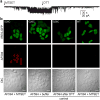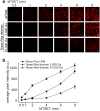Controlled delivery of bioactive molecules into live cells using the bacterial mechanosensitive channel MscL
- PMID: 22871809
- PMCID: PMC3651673
- DOI: 10.1038/ncomms1999
Controlled delivery of bioactive molecules into live cells using the bacterial mechanosensitive channel MscL
Abstract
Bacterial mechanosensitive channels are some of the largest pores in nature. In particular, MscL, with a pore diameter >25 Å, allows passage of large organic ions and small proteins. Functional MscL reconstitution into lipids has been proposed for applications in vesicular-based drug release. Here we show that these channels can be functionally expressed in mammalian cells to afford rapid controlled uptake of membrane-impermeable molecules. We first demonstrate that MscL gating in response to increased membrane tension is preserved in mammalian cell membranes. Molecular delivery is controlled by adopting an established method of MscL charge-induced activation. We then determine pore size limitations using fluorescently labelled model cargoes. Finally, we activate MscL to introduce the cell-impermeable bi-cyclic peptide phalloidin, a specific marker for actin filaments, into cells. We propose that MscL will be a useful tool for gated and controlled delivery of bioactive molecules into cells.
Figures






Similar articles
-
The gating mechanism of the bacterial mechanosensitive channel MscL revealed by molecular dynamics simulations: from tension sensing to channel opening.Channels (Austin). 2012 Jul-Aug;6(4):317-31. doi: 10.4161/chan.21895. Channels (Austin). 2012. PMID: 23146938 Free PMC article.
-
Phosphatidylinositol is crucial for the mechanosensitivity of Mycobacterium tuberculosis MscL.Biochemistry. 2013 Aug 13;52(32):5415-20. doi: 10.1021/bi400790j. Epub 2013 Aug 1. Biochemistry. 2013. PMID: 23875651 Free PMC article.
-
Novel compounds that specifically bind and modulate MscL: insights into channel gating mechanisms.FASEB J. 2019 Mar;33(3):3180-3189. doi: 10.1096/fj.201801628R. Epub 2018 Oct 25. FASEB J. 2019. PMID: 30359098 Free PMC article.
-
Life with Bacterial Mechanosensitive Channels, from Discovery to Physiology to Pharmacological Target.Microbiol Mol Biol Rev. 2020 Jan 15;84(1):e00055-19. doi: 10.1128/MMBR.00055-19. Print 2020 Feb 19. Microbiol Mol Biol Rev. 2020. PMID: 31941768 Free PMC article. Review.
-
Mechanosensitive channels of Escherichia coli: the MscL gene, protein, and activities.Annu Rev Physiol. 1997;59:633-57. doi: 10.1146/annurev.physiol.59.1.633. Annu Rev Physiol. 1997. PMID: 9074781 Review.
Cited by
-
Getting across the cell membrane: an overview for small molecules, peptides, and proteins.Methods Mol Biol. 2015;1266:29-53. doi: 10.1007/978-1-4939-2272-7_3. Methods Mol Biol. 2015. PMID: 25560066 Free PMC article. Review.
-
An agonist of the MscL channel affects multiple bacterial species and increases membrane permeability and potency of common antibiotics.Mol Microbiol. 2019 Sep;112(3):896-905. doi: 10.1111/mmi.14325. Epub 2019 Jun 8. Mol Microbiol. 2019. PMID: 31177589 Free PMC article.
-
Xerocytosis is caused by mutations that alter the kinetics of the mechanosensitive channel PIEZO1.Proc Natl Acad Sci U S A. 2013 Mar 19;110(12):E1162-8. doi: 10.1073/pnas.1219777110. Epub 2013 Mar 4. Proc Natl Acad Sci U S A. 2013. PMID: 23487776 Free PMC article.
-
Functional similarities between heterogeneously and homogenously expressed MscL constructs.Eur Biophys J. 2015 Oct;44(7):589-98. doi: 10.1007/s00249-015-1062-5. Epub 2015 Aug 2. Eur Biophys J. 2015. PMID: 26233759
-
Response of heterologously expressed pressure sensor-actuator-modulator macromolecule to external mechanical stress.Heliyon. 2024 Apr 4;10(8):e29195. doi: 10.1016/j.heliyon.2024.e29195. eCollection 2024 Apr 30. Heliyon. 2024. PMID: 38644861 Free PMC article.
References
-
- Hamill OP, Martinac B. Molecular basis of mechanotransduction in living cells. Physiol Rev. 2001;81:685–740. - PubMed
-
- Martinac B. Mechanosensitive ion channels: molecules of mechanotransduction. J Cell Sci. 2004;117:2449–2460. - PubMed
-
- Sukharev SI, Blount P, Martinac B, Blattner FR, Kung C. A large-conductance mechanosensitive channel in E.coli encoded by mscL alone. Nature. 1994;368:265–268. - PubMed
-
- Blount P, Schroeder MJ, Kung C. Mutations in a bacterial mechanosensitive channel change the cellular response to osmotic stress. J Biol Chem. 1997;272:32150–32157. - PubMed
Publication types
MeSH terms
Substances
Grants and funding
LinkOut - more resources
Full Text Sources
Other Literature Sources

